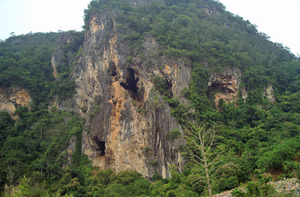
|
| ©National Geographic/Huang Wanbo |
| The bamboo-covered terrain of Hainan, China, was once home to ancient pandas and giant apes, new fossils found in this limestone cave suggest. |
The 400,000-year-old fossils of a giant panda were uncovered alongside the remains of a titan-sized, ancient ape called Gigantopithecus blacki, said Huang Wanbo, a paleontologist at Beijing's Institute of Vertebrate Paleontology and Paleoanthropology.
Excavated from a limestone cave on the island province of Hainan, the fossils suggest that both the giant pandas and the Giganto apes survived on a mostly bamboo diet, said Huang.
Hainan island was a bamboo-covered, hilly peninsula 400,000 years ago, Huang said. Today it is an island separated from the Chinese mainland by a 15-mile-wide (25-kilometer-wide) strait. (See map.)
Three-Way Competition
Russell Ciochon, a professor at the University of Iowa who has joined several fossil digs in China but was not involved in the Hainan excavation, said the findings expand the known geographic range of nine- to ten-foot (three-meter) Giganto, which he called "the largest ape that ever existed."
The Giganto ape became extinct about 300,000 years ago, after about a half-million years of overlap with early humans, according to Ciochon.
Huang said he believes the ape lost out in a three-way struggle with giant pandas and early humans over food and habitat.
Ancient panda fossils have been found before near Giganto ape remnants, and early human fossils in China have been found in the vicinity of ancient pandas.
If early humans - armed with primitive weapons like stone axes and fire - migrated like the panda through what is now southern China, they likely had contact with the giant apes, Huang said.
Fossils of this early human species - a hunter-gatherer known as Peking Man or Homo erectus - have been uncovered around Beijing in northern China, about 1,200 miles (2,000 kilometers) north of Hainan.
Ciochon said he once agreed that the Giganto ape was the first loser in a survival competition with pandas and primitive humans, but today he is not so sure.
"The panda and the Giganto were living side by side in these subtropical forests, and probably competing for food resources," he said, "but Homo erectus was likely to be living in other habitats."
No Homo erectus fossils have been found in what is now southern China, but the area has not been thoroughly studied by paleontologists.
Panda Struggles
Huang said that the Hainan panda fossil provided a new piece in the puzzle of the panda's eight-million-year-long evolution from a meat-eater into a reclusive bamboo-eater.
The earliest pandas were fierce carnivores, scientists say. While technically classified as omnivores, today's pandas primarily depend on bamboo, which they spend an average of 12 hours a day eating.
The new fossils suggest the panda of 400,000 years ago, which was slightly larger than the modern giant panda, had by that time already become completely dependent on bamboo for survival, Huang said.
Huang said pandas were traditionally hunted for their pelts, and this may have been the case as far back as several hundred thousand years ago.
According to Huang, "400,000 years ago, there were many more pandas than humans here."
The human population in China has since grown to more than 1.3 billion, while the number of pandas has dwindled to about 1,600, according to Chinese conservationists.
Alarmed by a government inspection that turned up only 1,100 giant pandas in the late 1980s, China began at that time working with a global coalition of conservationists to save the species.
Fan Zhiyong, species program director for the conservation nonprofit WWF China, said the giant panda population has been decimated by large-scale human activities including "road and dam construction, mining, tourism, logging, and poaching."
Making panda poaching a capital crime, setting up a patchwork of panda nature reserves in the Himalayan foothills of western China, and creating a captive breeding program have all helped forestall the panda's extinction, conservationists say.
Paleontologist Huang, meanwhile, has proposed creating a panda DNA database that could help map the evolutionary history of the giant panda. He said that unlocking the secrets of the panda's genetic past might one day provide the key to protecting its future.



Reader Comments
to our Newsletter